Leadership Management: Institutionalization of Change Report Analysis
VerifiedAdded on 2022/08/29
|9
|1749
|24
Report
AI Summary
This report comprehensively examines the institutionalization of change within organizations, addressing key aspects of the change process. It begins by defining institutionalization and exploring how organizational characteristics, such as stakeholder involvement and environmental stability, influence its success. The report then details assessment methods to determine the presence of institutionalization, identifying outcomes like improved employee performance and amended administrative practices. It also highlights factors that can hinder institutionalization, such as lack of commitment and ineffective group dynamics. Furthermore, the report discusses how managers can foster continuous change and improvement through alignment of organizational missions, transparent communication, and employee empowerment. Finally, it explores future trends, including globalization, workforce changes, and technological advancements, and their impact on the manager's role in institutionalizing change, providing examples relevant to various workplace environments. The report is based on the provided assignment brief, and includes relevant references from academic sources.
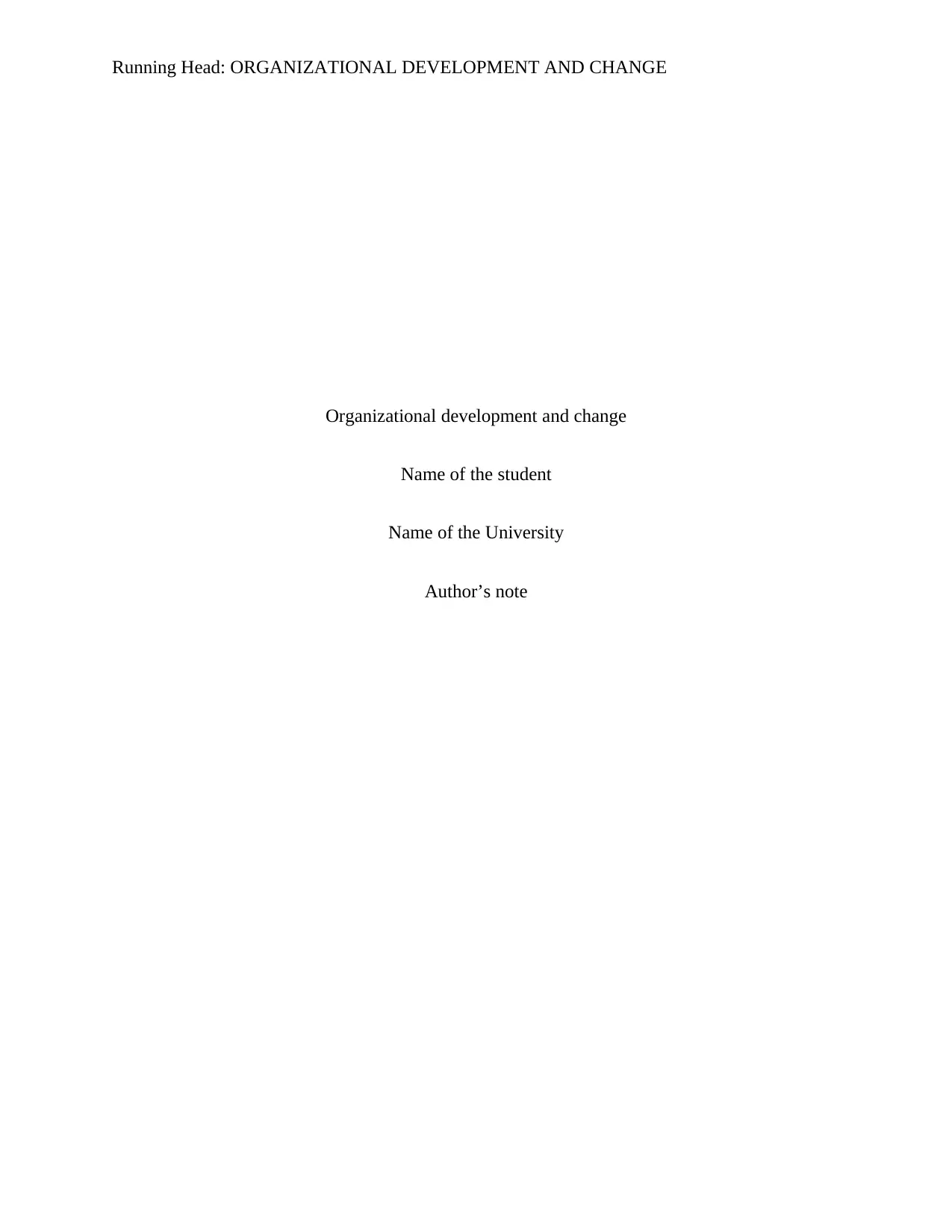
Running Head: ORGANIZATIONAL DEVELOPMENT AND CHANGE
Organizational development and change
Name of the student
Name of the University
Author’s note
Organizational development and change
Name of the student
Name of the University
Author’s note
Paraphrase This Document
Need a fresh take? Get an instant paraphrase of this document with our AI Paraphraser
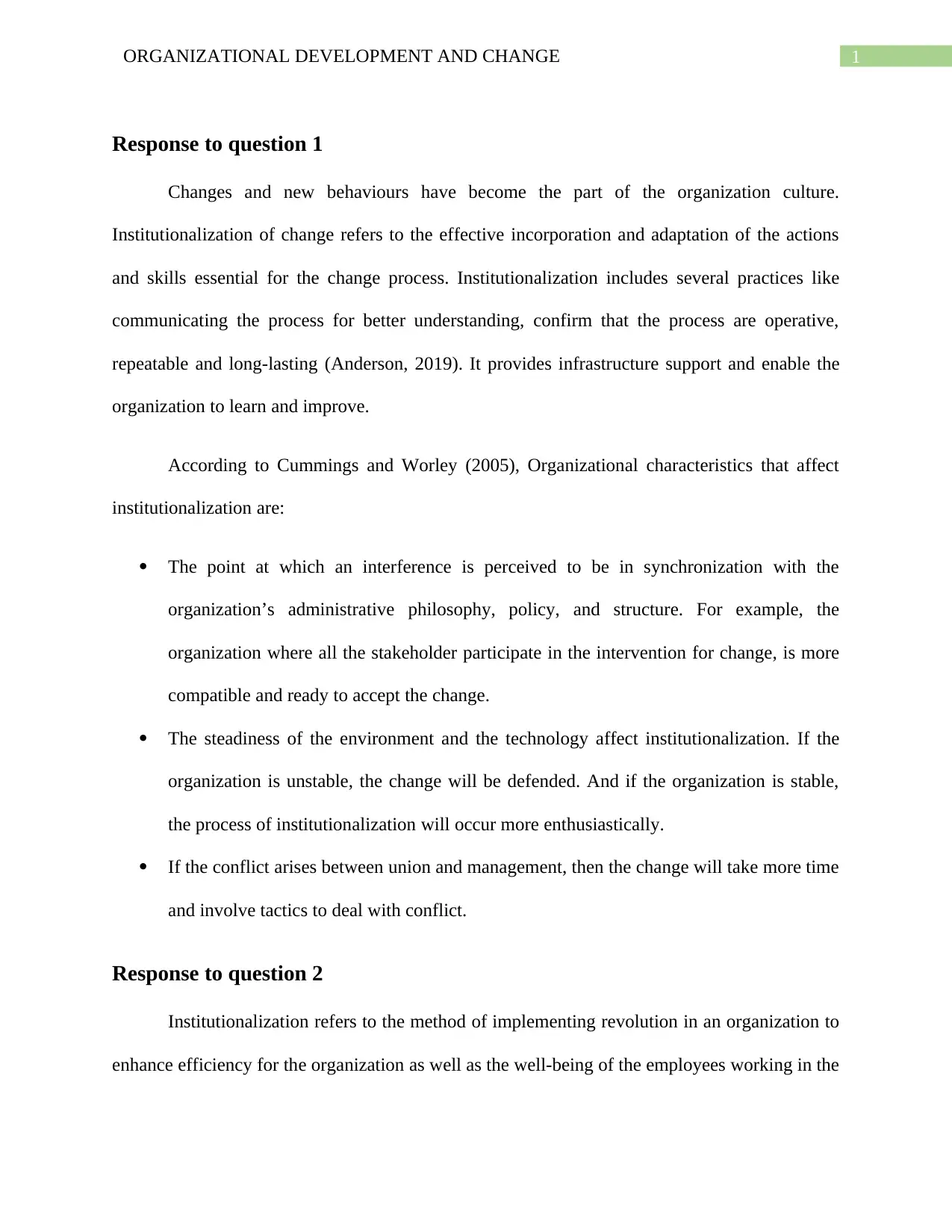
1ORGANIZATIONAL DEVELOPMENT AND CHANGE
Response to question 1
Changes and new behaviours have become the part of the organization culture.
Institutionalization of change refers to the effective incorporation and adaptation of the actions
and skills essential for the change process. Institutionalization includes several practices like
communicating the process for better understanding, confirm that the process are operative,
repeatable and long-lasting (Anderson, 2019). It provides infrastructure support and enable the
organization to learn and improve.
According to Cummings and Worley (2005), Organizational characteristics that affect
institutionalization are:
The point at which an interference is perceived to be in synchronization with the
organization’s administrative philosophy, policy, and structure. For example, the
organization where all the stakeholder participate in the intervention for change, is more
compatible and ready to accept the change.
The steadiness of the environment and the technology affect institutionalization. If the
organization is unstable, the change will be defended. And if the organization is stable,
the process of institutionalization will occur more enthusiastically.
If the conflict arises between union and management, then the change will take more time
and involve tactics to deal with conflict.
Response to question 2
Institutionalization refers to the method of implementing revolution in an organization to
enhance efficiency for the organization as well as the well-being of the employees working in the
Response to question 1
Changes and new behaviours have become the part of the organization culture.
Institutionalization of change refers to the effective incorporation and adaptation of the actions
and skills essential for the change process. Institutionalization includes several practices like
communicating the process for better understanding, confirm that the process are operative,
repeatable and long-lasting (Anderson, 2019). It provides infrastructure support and enable the
organization to learn and improve.
According to Cummings and Worley (2005), Organizational characteristics that affect
institutionalization are:
The point at which an interference is perceived to be in synchronization with the
organization’s administrative philosophy, policy, and structure. For example, the
organization where all the stakeholder participate in the intervention for change, is more
compatible and ready to accept the change.
The steadiness of the environment and the technology affect institutionalization. If the
organization is unstable, the change will be defended. And if the organization is stable,
the process of institutionalization will occur more enthusiastically.
If the conflict arises between union and management, then the change will take more time
and involve tactics to deal with conflict.
Response to question 2
Institutionalization refers to the method of implementing revolution in an organization to
enhance efficiency for the organization as well as the well-being of the employees working in the
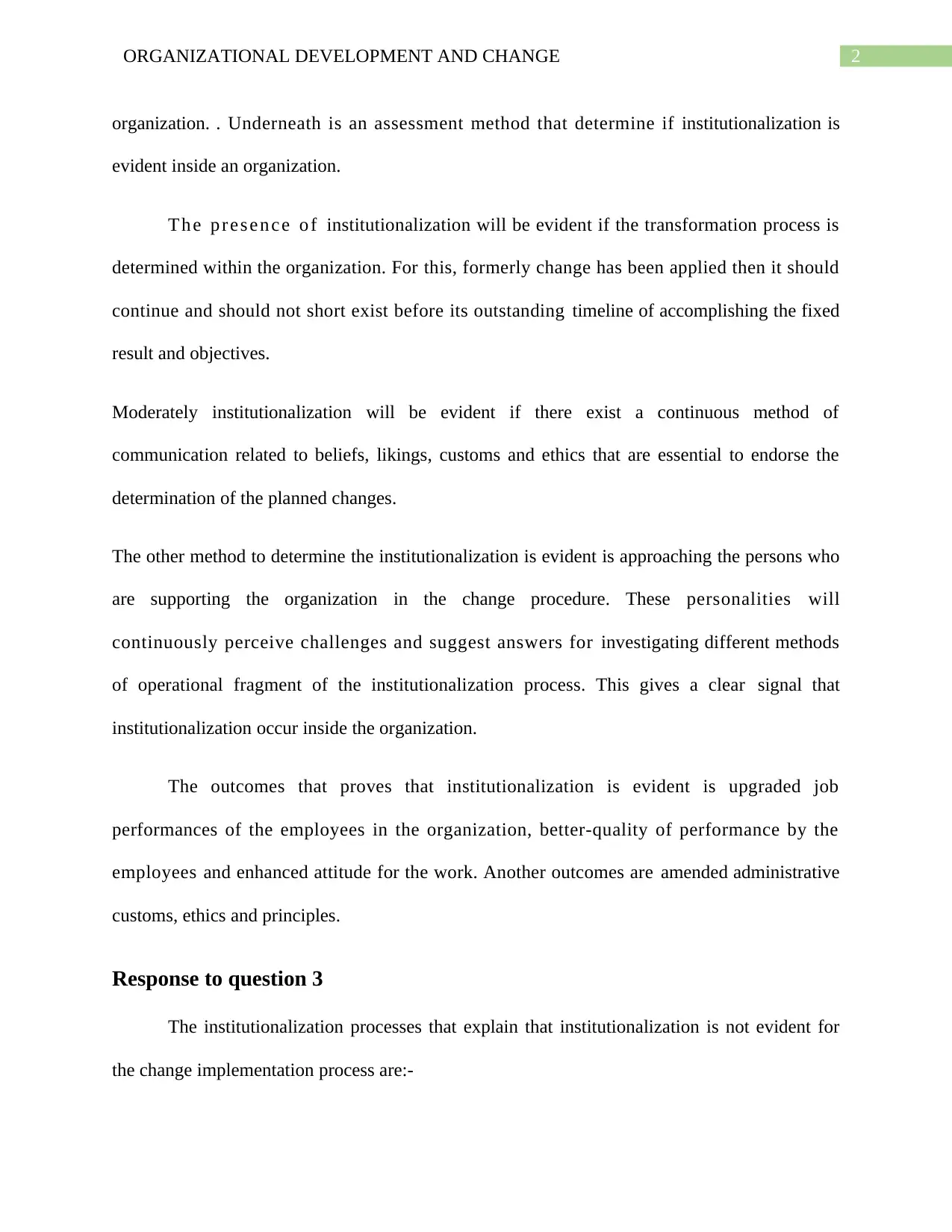
2ORGANIZATIONAL DEVELOPMENT AND CHANGE
organization. . Underneath is an assessment method that determine if institutionalization is
evident inside an organization.
T h e p r e s e n c e o f institutionalization will be evident if the transformation process is
determined within the organization. For this, formerly change has been applied then it should
continue and should not short exist before its outstanding timeline of accomplishing the fixed
result and objectives.
Moderately institutionalization will be evident if there exist a continuous method of
communication related to beliefs, likings, customs and ethics that are essential to endorse the
determination of the planned changes.
The other method to determine the institutionalization is evident is approaching the persons who
are supporting the organization in the change procedure. These personalities will
continuously perceive challenges and suggest answers for investigating different methods
of operational fragment of the institutionalization process. This gives a clear signal that
institutionalization occur inside the organization.
The outcomes that proves that institutionalization is evident is upgraded job
performances of the employees in the organization, better-quality of performance by the
employees and enhanced attitude for the work. Another outcomes are amended administrative
customs, ethics and principles.
Response to question 3
The institutionalization processes that explain that institutionalization is not evident for
the change implementation process are:-
organization. . Underneath is an assessment method that determine if institutionalization is
evident inside an organization.
T h e p r e s e n c e o f institutionalization will be evident if the transformation process is
determined within the organization. For this, formerly change has been applied then it should
continue and should not short exist before its outstanding timeline of accomplishing the fixed
result and objectives.
Moderately institutionalization will be evident if there exist a continuous method of
communication related to beliefs, likings, customs and ethics that are essential to endorse the
determination of the planned changes.
The other method to determine the institutionalization is evident is approaching the persons who
are supporting the organization in the change procedure. These personalities will
continuously perceive challenges and suggest answers for investigating different methods
of operational fragment of the institutionalization process. This gives a clear signal that
institutionalization occur inside the organization.
The outcomes that proves that institutionalization is evident is upgraded job
performances of the employees in the organization, better-quality of performance by the
employees and enhanced attitude for the work. Another outcomes are amended administrative
customs, ethics and principles.
Response to question 3
The institutionalization processes that explain that institutionalization is not evident for
the change implementation process are:-
⊘ This is a preview!⊘
Do you want full access?
Subscribe today to unlock all pages.

Trusted by 1+ million students worldwide

3ORGANIZATIONAL DEVELOPMENT AND CHANGE
The individual level of analysis the process of institutionalizing new conduct in the
organization and employees are anticipated to implement the introduced conduct in the
workplace. For this, many elements are put into concern like, the capability to accomplish while
accepting the new behaviour and the anticipated consequence from accepting the newly
presented conduct. Achievement and pledge is very essential for this step since they evidently
certify that the new behaviour happens and the employees are dedicated to accepting the
innovative changes (Brunsson & Olsen, 2018). Lack of commitment and attainment, then it is
evident that institutionalization cannot take place in the organization.
Group dynamics for detection and solving the problems is an innovative way of
institutionalizing the change. But if the management and the employees does not collaborate for
solutions at every step then this step will prove to be in evident for the change.
The allocation of reward for the change is only possible if it is done intrinsically as well
as extrinsically. Because rewards acts as motivation for accepting and doing new things during a
change process. Therefore, if the employees lack motivation and remuneration then it can be in
evident for institutionalizing a change.
Response to question 4
Organization culture involves how the organization express its identity and purposes. It is
the foundation of the organization and combines elements like values, beliefs and assumptions.
The aspect that is put into concern while building organizational culture is the demand of the
industry. Managing change successfully in organizations is a skill that needs continuous planning
and expansion. Management is concerned with the optimal achievement of organizational goals
and purposes through implementation of interventions and involvement of the employees.
The individual level of analysis the process of institutionalizing new conduct in the
organization and employees are anticipated to implement the introduced conduct in the
workplace. For this, many elements are put into concern like, the capability to accomplish while
accepting the new behaviour and the anticipated consequence from accepting the newly
presented conduct. Achievement and pledge is very essential for this step since they evidently
certify that the new behaviour happens and the employees are dedicated to accepting the
innovative changes (Brunsson & Olsen, 2018). Lack of commitment and attainment, then it is
evident that institutionalization cannot take place in the organization.
Group dynamics for detection and solving the problems is an innovative way of
institutionalizing the change. But if the management and the employees does not collaborate for
solutions at every step then this step will prove to be in evident for the change.
The allocation of reward for the change is only possible if it is done intrinsically as well
as extrinsically. Because rewards acts as motivation for accepting and doing new things during a
change process. Therefore, if the employees lack motivation and remuneration then it can be in
evident for institutionalizing a change.
Response to question 4
Organization culture involves how the organization express its identity and purposes. It is
the foundation of the organization and combines elements like values, beliefs and assumptions.
The aspect that is put into concern while building organizational culture is the demand of the
industry. Managing change successfully in organizations is a skill that needs continuous planning
and expansion. Management is concerned with the optimal achievement of organizational goals
and purposes through implementation of interventions and involvement of the employees.
Paraphrase This Document
Need a fresh take? Get an instant paraphrase of this document with our AI Paraphraser
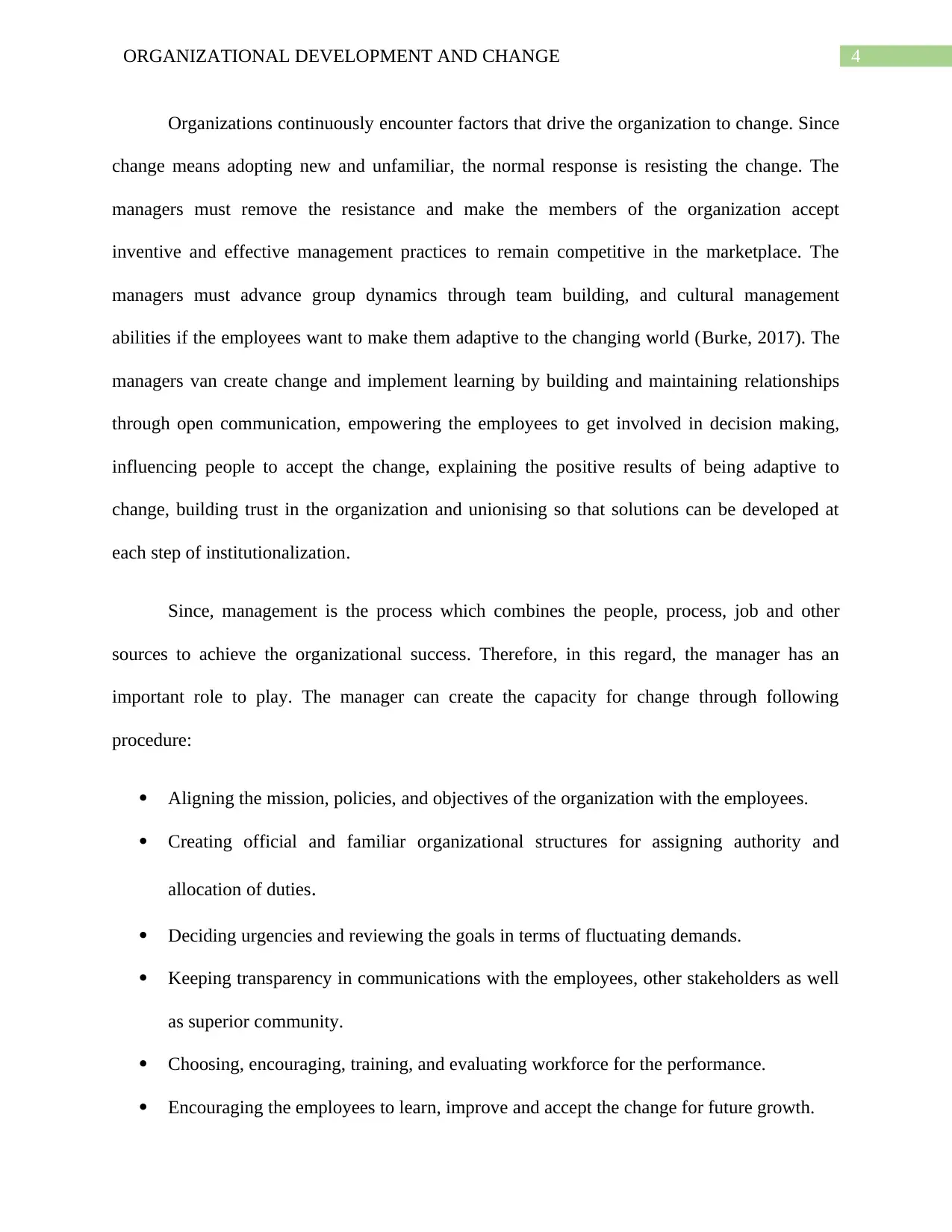
4ORGANIZATIONAL DEVELOPMENT AND CHANGE
Organizations continuously encounter factors that drive the organization to change. Since
change means adopting new and unfamiliar, the normal response is resisting the change. The
managers must remove the resistance and make the members of the organization accept
inventive and effective management practices to remain competitive in the marketplace. The
managers must advance group dynamics through team building, and cultural management
abilities if the employees want to make them adaptive to the changing world (Burke, 2017). The
managers van create change and implement learning by building and maintaining relationships
through open communication, empowering the employees to get involved in decision making,
influencing people to accept the change, explaining the positive results of being adaptive to
change, building trust in the organization and unionising so that solutions can be developed at
each step of institutionalization.
Since, management is the process which combines the people, process, job and other
sources to achieve the organizational success. Therefore, in this regard, the manager has an
important role to play. The manager can create the capacity for change through following
procedure:
Aligning the mission, policies, and objectives of the organization with the employees.
Creating official and familiar organizational structures for assigning authority and
allocation of duties.
Deciding urgencies and reviewing the goals in terms of fluctuating demands.
Keeping transparency in communications with the employees, other stakeholders as well
as superior community.
Choosing, encouraging, training, and evaluating workforce for the performance.
Encouraging the employees to learn, improve and accept the change for future growth.
Organizations continuously encounter factors that drive the organization to change. Since
change means adopting new and unfamiliar, the normal response is resisting the change. The
managers must remove the resistance and make the members of the organization accept
inventive and effective management practices to remain competitive in the marketplace. The
managers must advance group dynamics through team building, and cultural management
abilities if the employees want to make them adaptive to the changing world (Burke, 2017). The
managers van create change and implement learning by building and maintaining relationships
through open communication, empowering the employees to get involved in decision making,
influencing people to accept the change, explaining the positive results of being adaptive to
change, building trust in the organization and unionising so that solutions can be developed at
each step of institutionalization.
Since, management is the process which combines the people, process, job and other
sources to achieve the organizational success. Therefore, in this regard, the manager has an
important role to play. The manager can create the capacity for change through following
procedure:
Aligning the mission, policies, and objectives of the organization with the employees.
Creating official and familiar organizational structures for assigning authority and
allocation of duties.
Deciding urgencies and reviewing the goals in terms of fluctuating demands.
Keeping transparency in communications with the employees, other stakeholders as well
as superior community.
Choosing, encouraging, training, and evaluating workforce for the performance.
Encouraging the employees to learn, improve and accept the change for future growth.
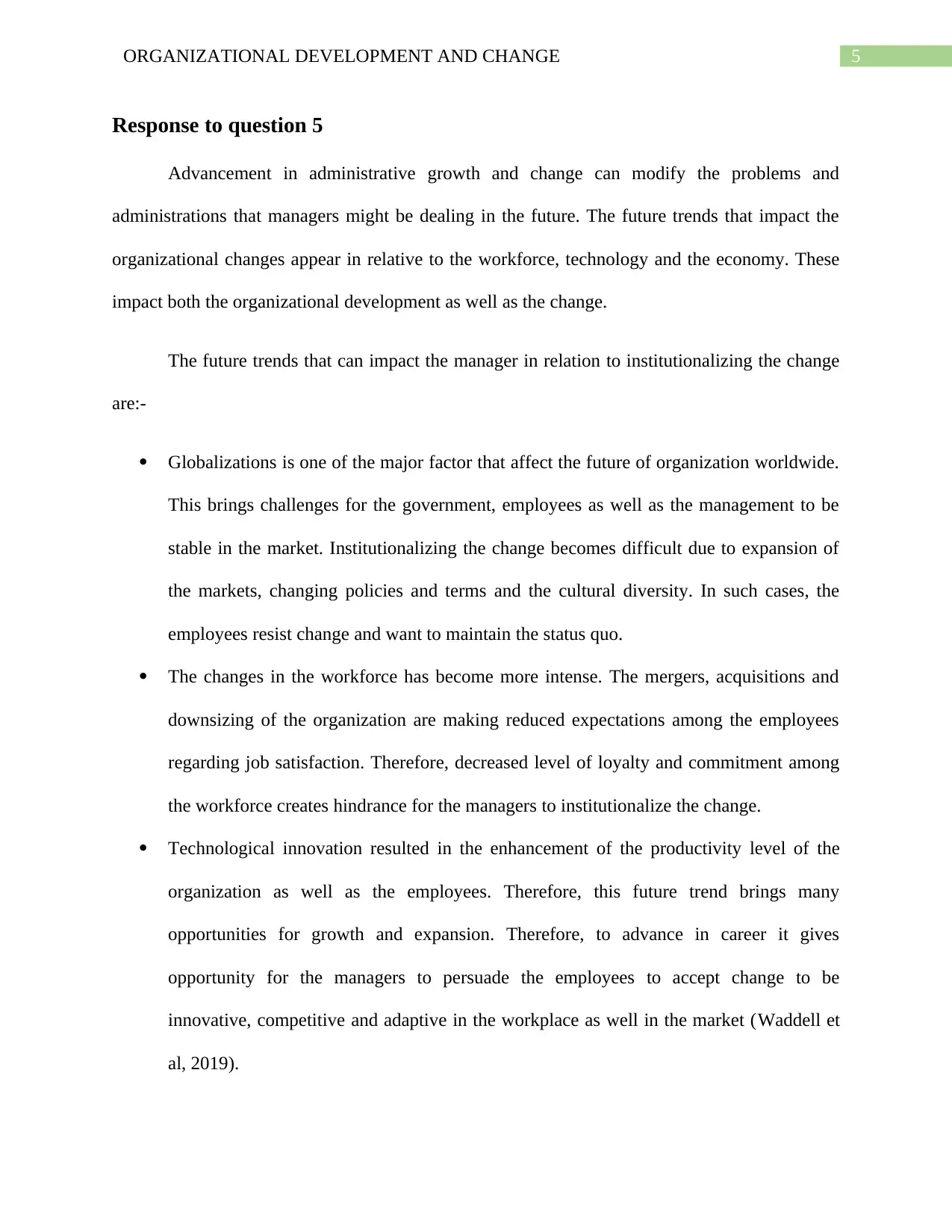
5ORGANIZATIONAL DEVELOPMENT AND CHANGE
Response to question 5
Advancement in administrative growth and change can modify the problems and
administrations that managers might be dealing in the future. The future trends that impact the
organizational changes appear in relative to the workforce, technology and the economy. These
impact both the organizational development as well as the change.
The future trends that can impact the manager in relation to institutionalizing the change
are:-
Globalizations is one of the major factor that affect the future of organization worldwide.
This brings challenges for the government, employees as well as the management to be
stable in the market. Institutionalizing the change becomes difficult due to expansion of
the markets, changing policies and terms and the cultural diversity. In such cases, the
employees resist change and want to maintain the status quo.
The changes in the workforce has become more intense. The mergers, acquisitions and
downsizing of the organization are making reduced expectations among the employees
regarding job satisfaction. Therefore, decreased level of loyalty and commitment among
the workforce creates hindrance for the managers to institutionalize the change.
Technological innovation resulted in the enhancement of the productivity level of the
organization as well as the employees. Therefore, this future trend brings many
opportunities for growth and expansion. Therefore, to advance in career it gives
opportunity for the managers to persuade the employees to accept change to be
innovative, competitive and adaptive in the workplace as well in the market (Waddell et
al, 2019).
Response to question 5
Advancement in administrative growth and change can modify the problems and
administrations that managers might be dealing in the future. The future trends that impact the
organizational changes appear in relative to the workforce, technology and the economy. These
impact both the organizational development as well as the change.
The future trends that can impact the manager in relation to institutionalizing the change
are:-
Globalizations is one of the major factor that affect the future of organization worldwide.
This brings challenges for the government, employees as well as the management to be
stable in the market. Institutionalizing the change becomes difficult due to expansion of
the markets, changing policies and terms and the cultural diversity. In such cases, the
employees resist change and want to maintain the status quo.
The changes in the workforce has become more intense. The mergers, acquisitions and
downsizing of the organization are making reduced expectations among the employees
regarding job satisfaction. Therefore, decreased level of loyalty and commitment among
the workforce creates hindrance for the managers to institutionalize the change.
Technological innovation resulted in the enhancement of the productivity level of the
organization as well as the employees. Therefore, this future trend brings many
opportunities for growth and expansion. Therefore, to advance in career it gives
opportunity for the managers to persuade the employees to accept change to be
innovative, competitive and adaptive in the workplace as well in the market (Waddell et
al, 2019).
⊘ This is a preview!⊘
Do you want full access?
Subscribe today to unlock all pages.

Trusted by 1+ million students worldwide

6ORGANIZATIONAL DEVELOPMENT AND CHANGE
The future trend like innovative technologies and interventions will enhance the phases
involve in the change. The technologies such as groupware and video conferencing can
be implemented to encourage employees to come together and involve in the change.
The rise of the diverse workforce will impact the management in introducing the change
specifically in large organizations due to cross-cultural issues. Therefore, the organization
needs to speed up its processes and become more flexible and adaptive to establish itself
as a result-oriented organization.
The future trend like innovative technologies and interventions will enhance the phases
involve in the change. The technologies such as groupware and video conferencing can
be implemented to encourage employees to come together and involve in the change.
The rise of the diverse workforce will impact the management in introducing the change
specifically in large organizations due to cross-cultural issues. Therefore, the organization
needs to speed up its processes and become more flexible and adaptive to establish itself
as a result-oriented organization.
Paraphrase This Document
Need a fresh take? Get an instant paraphrase of this document with our AI Paraphraser
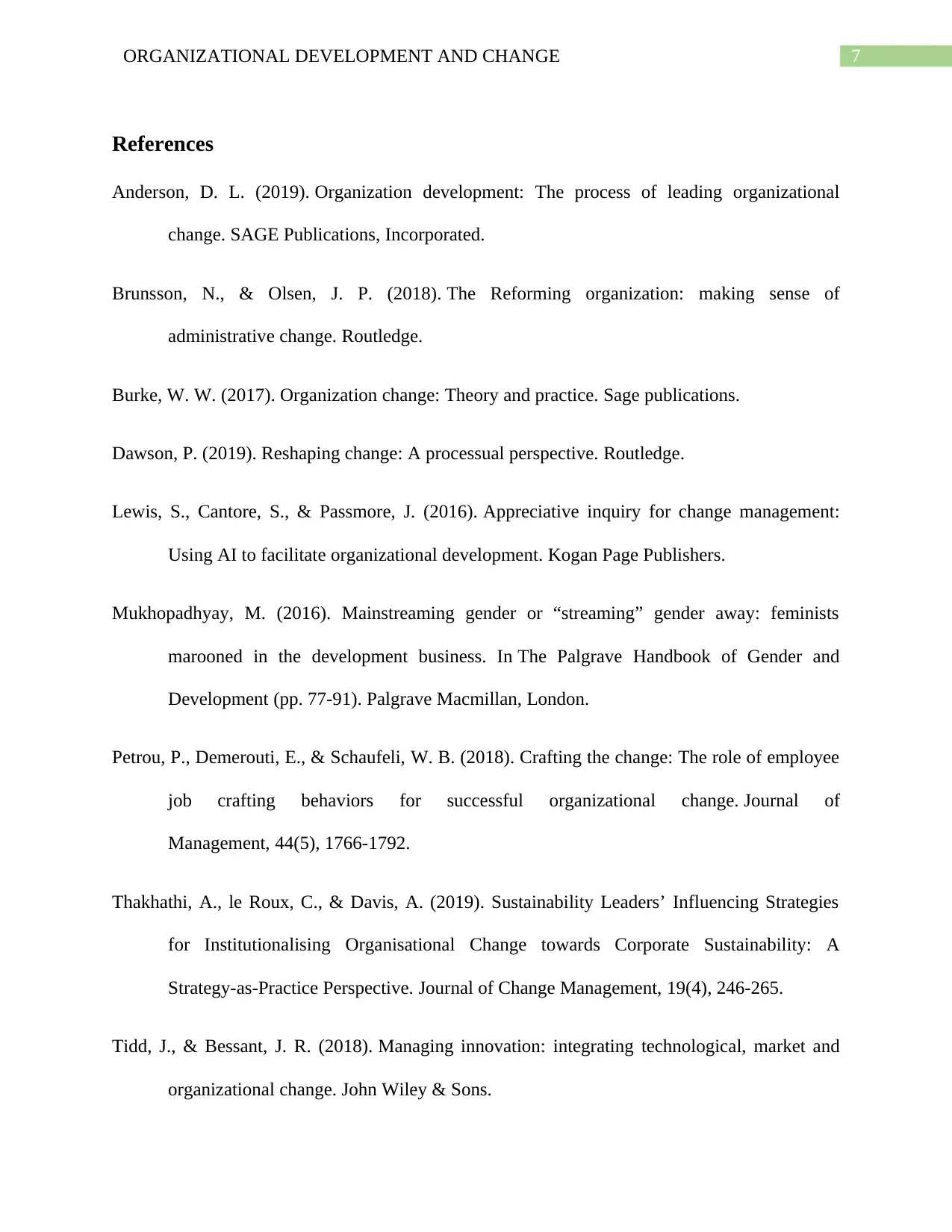
7ORGANIZATIONAL DEVELOPMENT AND CHANGE
References
Anderson, D. L. (2019). Organization development: The process of leading organizational
change. SAGE Publications, Incorporated.
Brunsson, N., & Olsen, J. P. (2018). The Reforming organization: making sense of
administrative change. Routledge.
Burke, W. W. (2017). Organization change: Theory and practice. Sage publications.
Dawson, P. (2019). Reshaping change: A processual perspective. Routledge.
Lewis, S., Cantore, S., & Passmore, J. (2016). Appreciative inquiry for change management:
Using AI to facilitate organizational development. Kogan Page Publishers.
Mukhopadhyay, M. (2016). Mainstreaming gender or “streaming” gender away: feminists
marooned in the development business. In The Palgrave Handbook of Gender and
Development (pp. 77-91). Palgrave Macmillan, London.
Petrou, P., Demerouti, E., & Schaufeli, W. B. (2018). Crafting the change: The role of employee
job crafting behaviors for successful organizational change. Journal of
Management, 44(5), 1766-1792.
Thakhathi, A., le Roux, C., & Davis, A. (2019). Sustainability Leaders’ Influencing Strategies
for Institutionalising Organisational Change towards Corporate Sustainability: A
Strategy-as-Practice Perspective. Journal of Change Management, 19(4), 246-265.
Tidd, J., & Bessant, J. R. (2018). Managing innovation: integrating technological, market and
organizational change. John Wiley & Sons.
References
Anderson, D. L. (2019). Organization development: The process of leading organizational
change. SAGE Publications, Incorporated.
Brunsson, N., & Olsen, J. P. (2018). The Reforming organization: making sense of
administrative change. Routledge.
Burke, W. W. (2017). Organization change: Theory and practice. Sage publications.
Dawson, P. (2019). Reshaping change: A processual perspective. Routledge.
Lewis, S., Cantore, S., & Passmore, J. (2016). Appreciative inquiry for change management:
Using AI to facilitate organizational development. Kogan Page Publishers.
Mukhopadhyay, M. (2016). Mainstreaming gender or “streaming” gender away: feminists
marooned in the development business. In The Palgrave Handbook of Gender and
Development (pp. 77-91). Palgrave Macmillan, London.
Petrou, P., Demerouti, E., & Schaufeli, W. B. (2018). Crafting the change: The role of employee
job crafting behaviors for successful organizational change. Journal of
Management, 44(5), 1766-1792.
Thakhathi, A., le Roux, C., & Davis, A. (2019). Sustainability Leaders’ Influencing Strategies
for Institutionalising Organisational Change towards Corporate Sustainability: A
Strategy-as-Practice Perspective. Journal of Change Management, 19(4), 246-265.
Tidd, J., & Bessant, J. R. (2018). Managing innovation: integrating technological, market and
organizational change. John Wiley & Sons.
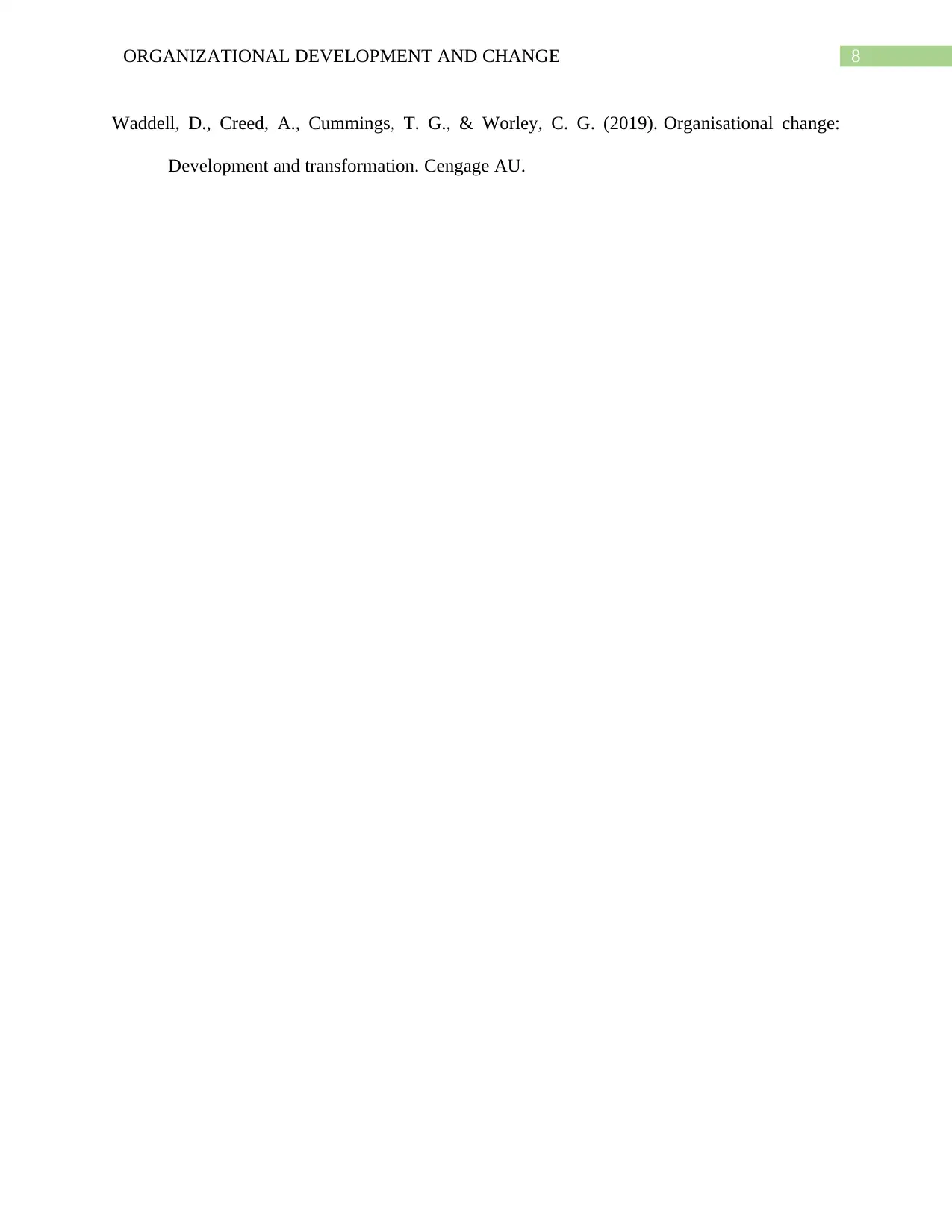
8ORGANIZATIONAL DEVELOPMENT AND CHANGE
Waddell, D., Creed, A., Cummings, T. G., & Worley, C. G. (2019). Organisational change:
Development and transformation. Cengage AU.
Waddell, D., Creed, A., Cummings, T. G., & Worley, C. G. (2019). Organisational change:
Development and transformation. Cengage AU.
⊘ This is a preview!⊘
Do you want full access?
Subscribe today to unlock all pages.

Trusted by 1+ million students worldwide
1 out of 9
Related Documents
Your All-in-One AI-Powered Toolkit for Academic Success.
+13062052269
info@desklib.com
Available 24*7 on WhatsApp / Email
![[object Object]](/_next/static/media/star-bottom.7253800d.svg)
Unlock your academic potential
Copyright © 2020–2025 A2Z Services. All Rights Reserved. Developed and managed by ZUCOL.





